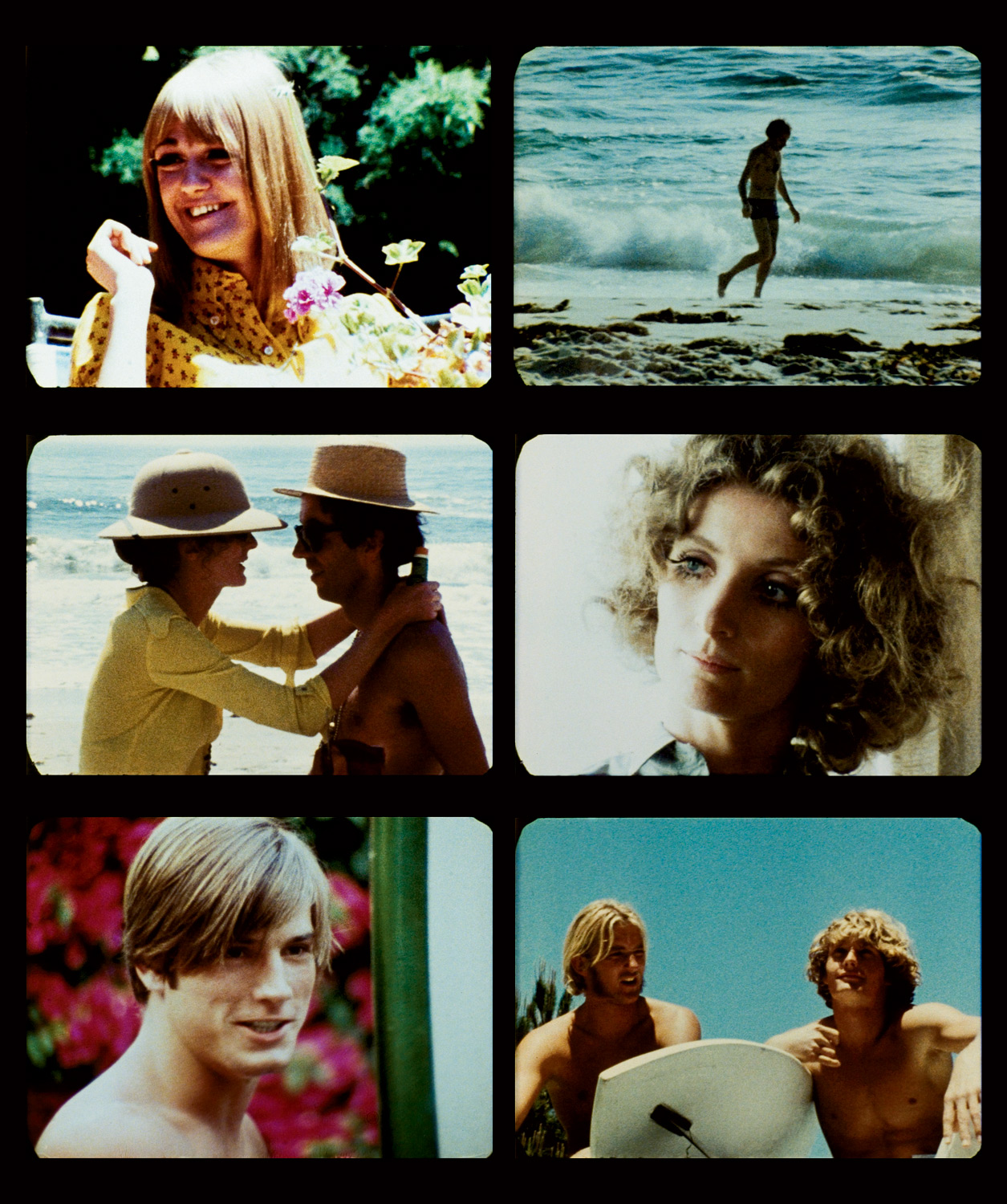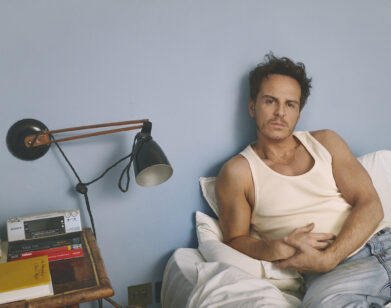New Wave Cinema

In May of 1968, Andy Warhol and several members of his art-world inner circle took up at a house in La Jolla, California, and began making a movie. This film was one of nearly a dozen cinematic efforts Warhol made with fellow filmmaker Paul Morrissey—and as it happened, one of his very last (due, in part, to the fact that Warhol would be almost fatally shot by Valerie Solanas, which had radical consequences on his creative practice). This film was about surfers, although most of the cast couldn’t surf. And, like so many films in the Warhol-Morrissey vein, this one would have no real script, no perceptible plot, a lot of on-the-spot improvisation, an almost claustrophobic reliance on close-ups, and, naturally, a heightened ambisexual subtext—where everyone seems ready and willing to have sex but somehow forgets to due to distraction by the end of the scene. But what sets San Diego Surf apart from the canon of Warhol’s other films is that it was never shown or released. In fact, it was never even edited until three decades later, in 1995, when the Andy Warhol Museum in Pittsburgh commissioned Morrissey to complete the tailoring job.
In 2012, the museum will finally bring San Diego Surf to the silver screen for the first time, and the ever-growing cult of the King of Pop Art can appreciate a never-before-seen Warhol feature in all of its rambling, candy-colored, sexually frustrating, lewd, obtuse, and hilarious glory. What viewers can expect is something along these lines: Superstars Taylor Mead and Viva playing a married golfing couple on the verge of divorce who are hoping to either reconcile and climb their way up the social hierarchy of another pastime, or separately have a fling with one of the shirtless local surfers (one of whom, when asked to ponder the universe, replies, “I hope there are waves on Mars”). San Diego Surf also features Joe Dallesandro as a black-sheep surfer from New York, Ingrid Superstar as a maybe-pregnant, surfer-hungry family friend, as well as the towheaded Tom Hompertz, the only Factory member who could actually ride the waves. Perhaps the film is summed up best by Viva’s opening lines: “Here I am, a nice, normal, middle-class housewife with a penchant for surfers.”
In celebration of the film’s arrival 44 years after it was captured on 16mm, Interview has put together an oral narrative as remembered by some of the key participants of the production. I conducted these short interviews by phone with Viva and Dallesandro in Los Angeles and Morrissey in New York City, and in person with Mead at the front table of the Bowery Poetry Club before one of his weekly readings. Of this band of truly outsized personalities with surprisingly decent memories, only Viva tried later to learn to surf.
TAYLOR MEAD: I remember we all flew out to L.A. to shoot the film, and I bounced one of the beautiful actors from a bedroom in the house we were staying at. Andy said, “Taylor’s the star, so you have to move. You have to sleep on the couch.” Viva and I played a married golfing couple, and Paul was working the camera. Of course, Paul claims he made all Andy’s films. Paul was a great influence—I mean, Andy was the influence, though. Andy could be in another room, and it would still be an Andy Warhol film. What I do remember vividly about shooting San Diego Surf was that the house we took was loaned to us by a local judge—one-story house, very nice, with a couple of bedrooms and a patio. And Viva, at one point, is holding the judge’s baby, and she drops the baby, and there’s a brick patio. I can’t remember if I caught the baby or Joe did, but one of us was a hero. I recall there being no real plot to San Diego Surf, no script. I remember once when I was filming Lonesome Cowboys [1968], I had read the synopsis before and, in one scene I said, “Well, Viva has this hacienda, you cowboys are all invited to come up,” and Andy said, “Too much plot.” So with San Diego Surf we just threw out the plot. Whatever happened, happened, and it was serendipitous, using whoever was around. Paul was the one who edited it. He did a very good job. But Andy was so indifferent to who actually ended up appearing in his films—you were in or out, he didn’t give a shit. I remember Ingrid Superstar. Dear Ingrid, so sweet. After we shot the film and flew back to New York, Ingrid started crying and Andy said, “Oh, Ingrid, don’t cry. You’re amongst friends.” [laughs] That’s Andy being treacherous. Friends! We were all sharks! But I heard that poor Ingrid was a victim of a serial killer. At any rate, she disappeared. She was actually the first superstar. And there was Joe. I was crazy about Joe. He was a fucking tease, a hustler. I wish I had offered him 10 bucks. [laughs] Anyway, for Andy’s films, I basically improvised. I could improvise forever. Andy just let me loose. But Andy, with his subtle, nonpresent kind of way, was a total influence. He was always lurking in the wings. Andy was shot just a few days after we came back from filming San Diego Surf. I wish I had been there because I had saved Andy from a previous gunman. I jumped the fucking gun, and I would have done it again. This time Paul and everyone sat around watching it like it was a movie.
VIVA: San Diego Surf needed an intervention from MGM. It had all of the elements of a really great romantic comedy, but it needed a stricter writer, another camera, an underwater camera, a boat, and decent direction. It also lacks travel shots. That’s why I was so stagnant in my scenes. I don’t remember much about shooting the film, other than being stopped by the police on the sidewalk as I was walking from one house we rented to another to do my laundry. I was wearing that same red crochet top that I have on in the movie. I can’t remember if they arrested me, but the police stopped me for not wearing a bra. The house we rented belonged to a judge. And, actually, I was holding their baby and I dropped it. Thank god Joe was there to catch it. I also remember a number of scenes with Taylor that got cut out of the film in favor of scenes with some unbelievably boring dialogue. Taylor was always funny; a brilliant genius. We had a scene of us playing golf that got cut and one of me being carried on a surfboard. I tried to put some kind of plot in the film, or at least some lines to lift it up. Paul always did some kind of basic abstract story for us to follow. But that whole ending where Taylor is begging the surfer “please pee on me!” really ruined the movie. But what could I say? I also remember at one point I was doing a scene on the beach with Taylor where I had to perform some dumb dance. I said, “Oh, no, I’m getting really sunburned. I’ve got to go in.” I went in the house and Andy ran after me and said, “Quick, get back out there. If you don’t, Paul won’t film you. He’ll only film the boys.” I said, “Andy, listen, I’m probably already sunburned even though you can’t see it yet. If I burn to death, you’ll have to take me to the hospital and spray cortisol all over my body.” He said, “You’re crazy. You’re totally white. Just like I am.” And one half of Andy’s face was almost purple it was so sunburned. He had been looking through the camera with one eye all day . . . But the reason we did a surf movie in the first place is because we were going around the country with Andy on his college lecture tour, and we were at the University of California in San Diego where we met these so-called surfers who were college kids. Surfing wasn’t that big of a thing back then, not like it is now. That’s how we got the idea. But poor Tom Hompertz, with Taylor begging for him to pee on him in that final scene, never losing that angelic, semi-innocent smile . . .
JOE DALLESANDRO: They put us all up out in La Jolla to make this movie, but soon they learned that none of us knew how to surf. I remember going out into the water and trying to get on a surfboard—my head was under water, and the surfboard was on top of me [laughs]. I could tell that I wasn’t doing very well. So basically what I ended up having to do was stand on the sand with the surfboard near me. That’s it. I mean, I couldn’t even sit on a surfboard in the water. And no one else fared very well with surfing either, expect for Tom, who already was a surfer. In terms of filming, we were always told what to do beforehand, but initially there wasn’t much for us to do. Andy never told us anything to do. It was Paul who gave us the direction. I only remember Andy once or twice behind the camera.
PAUL MORRISSEY: Andy Warhol’s movie? He didn’t have anything to do with it, except his terrible camera work, which I even had to take over most of the time. I did everything, everything, everything! Poor Andy couldn’t suggest a thing. He was so helpless. Andy had no idea what he was doing, but I had to give him something to do, so I let him operate the camera. He had no compositional sense or artistic sense of any kind as far as film was concerned. He was making footage. There was a hundred hours of footage there, and it’s unwatchable footage. You call that a movie?
. . . I remember that San Diego Surf didn’t work. I put it together mostly in front of the camera, suggesting what they say, and nothing happened. I knew nobody would sit through it. There just wasn’t enough there to edit. You can’t edit something that’s not good to begin with. The idea for a film with surfers came because Tom Hompertz, who was in Lonesome Cowboys, was a surfer. That’s all. I thought I’d use him. It was the same cast as Lonesome Cowboys. I did [the last scene, where Tom urinates on Mead] in New York because I knew there wasn’t enough movie there. I brought Tom to New York and that scene with Taylor was filmed on my desk at the office. By the way, I also photographed all of that film. Do you know what it means to photograph a movie? The man who directs the photography is the one who looks at the scene, looks at the lights, sets the light, and aims the camera from his position. The director of photography was me. The camera operator was Andy.
Photo: Stills from San Diego Surf, clockwise from top left: Ingrid Superstar, Taylor Mead, Viva, Tom Hompertz (right) with Local Surfer, Joe Dallesandro, and (left to right) Viva and Taylor Mead. All Images Courtesy of the Andy Warhol Museum.
Christopher Bollen is Interview’s Editor at Large.






